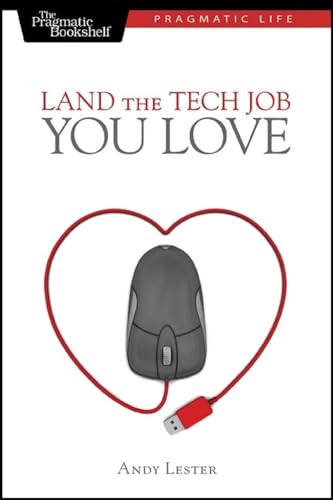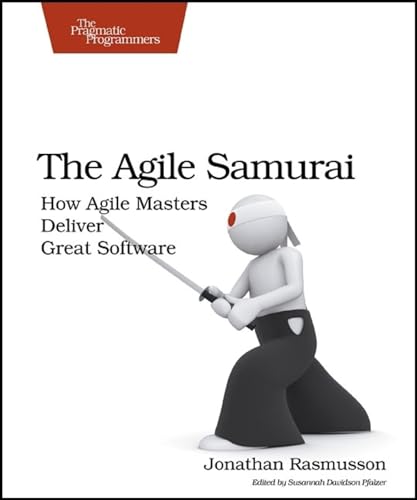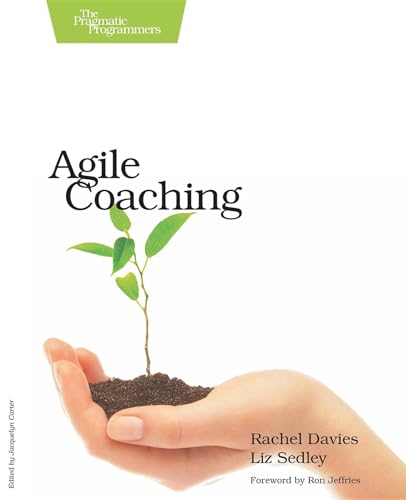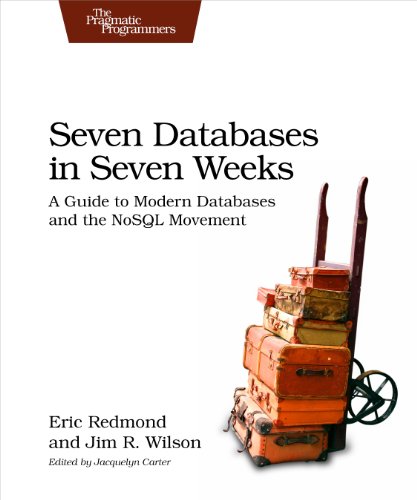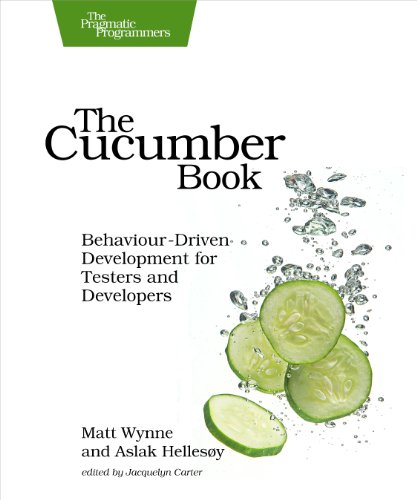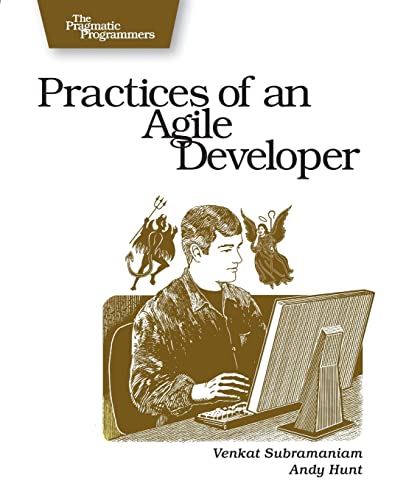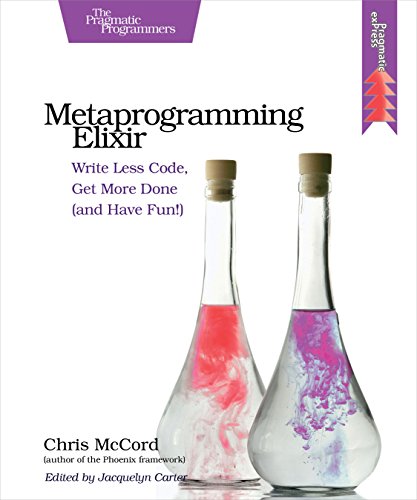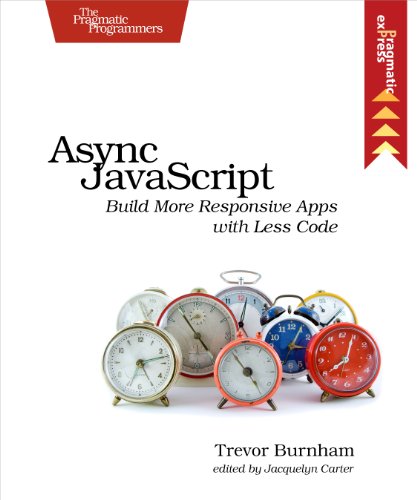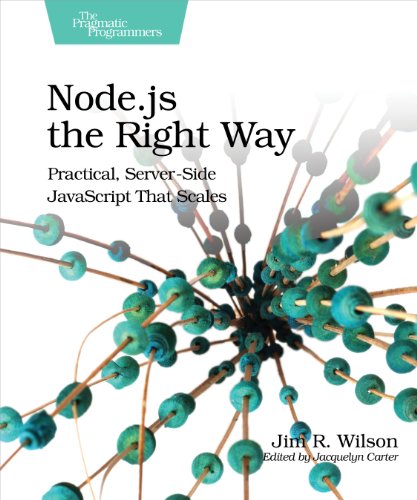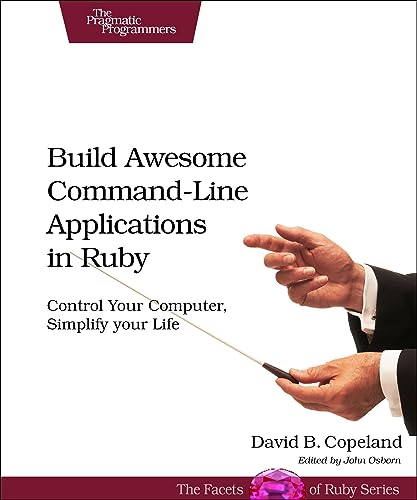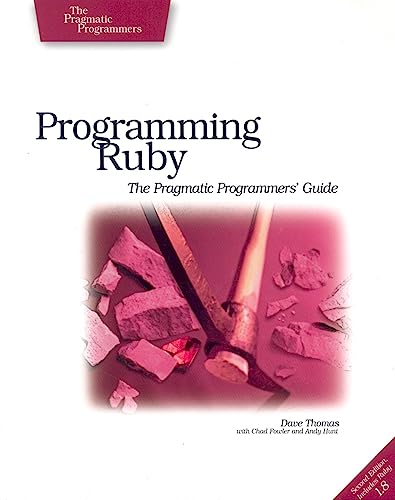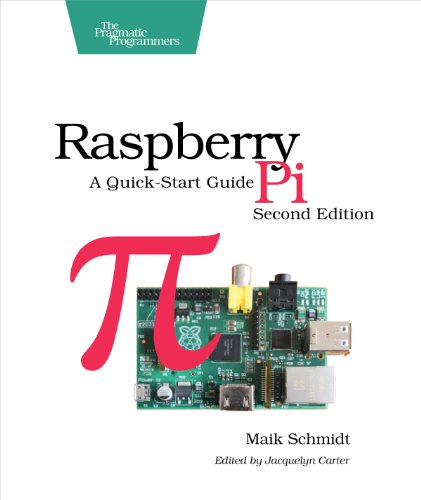the pragmatic programmers raleigh (367 results)
Search filters
Product Type
- All Product Types
- Books (367)
- Magazines & Periodicals (No further results match this refinement)
- Comics (No further results match this refinement)
- Sheet Music (No further results match this refinement)
- Art, Prints & Posters (No further results match this refinement)
- Photographs (No further results match this refinement)
- Maps (No further results match this refinement)
- Manuscripts & Paper Collectibles (No further results match this refinement)
Condition Learn more
- New (329)
- As New, Fine or Near Fine (1)
- Very Good or Good (36)
- Fair or Poor (1)
- As Described (No further results match this refinement)
Binding
- All Bindings
- Hardcover (No further results match this refinement)
- Softcover (366)
Collectible Attributes
- First Edition (No further results match this refinement)
- Signed (No further results match this refinement)
- Dust Jacket (No further results match this refinement)
- Seller-Supplied Images (7)
- Not Print on Demand (318)
Language (1)
Free Shipping
Seller Location
Seller Rating
-
Lean from the Trenches: Managing Large-Scale Projects with Kanban
Language: English
Published by The Pragmatic Programmers, United States, Raleigh, 2012
ISBN 10: 1934356859 ISBN 13: 9781934356852
Seller: WorldofBooks, Goring-By-Sea, WS, United Kingdom
Paperback. Condition: Very Good. The book has been read, but is in excellent condition. Pages are intact and not marred by notes or highlighting. The spine remains undamaged.
-
Land the Tech Job You Love
Book 2 of 3: Pragmatic LifeLanguage: English
Published by The Pragmatic Programmers, United States, Raleigh, 2009
ISBN 10: 1934356263 ISBN 13: 9781934356265
Seller: WorldofBooks, Goring-By-Sea, WS, United Kingdom
Paperback. Condition: Very Good. The book has been read, but is in excellent condition. Pages are intact and not marred by notes or highlighting. The spine remains undamaged.
-
The Agile Samurai: How Agile Masters Deliver Great Software (Pragmatic Programmers)
Language: English
Published by The Pragmatic Programmers, United States, Raleigh, 2010
ISBN 10: 1934356581 ISBN 13: 9781934356586
Seller: WorldofBooks, Goring-By-Sea, WS, United Kingdom
Paperback. Condition: Very Good. The book has been read, but is in excellent condition. Pages are intact and not marred by notes or highlighting. The spine remains undamaged.
-
Agile Coaching (Pragmatic Bookshelf Ser.)
Language: English
Published by The Pragmatic Programmers, United States, Raleigh, 2009
ISBN 10: 1934356433 ISBN 13: 9781934356432
Seller: WorldofBooks, Goring-By-Sea, WS, United Kingdom
Paperback. Condition: Very Good. The book has been read, but is in excellent condition. Pages are intact and not marred by notes or highlighting. The spine remains undamaged.
-
Seven Databases in Seven Weeks: A Guide to Modern Databases and the Nosql Movement
Language: English
Published by The Pragmatic Programmers, United States, Raleigh, 2012
ISBN 10: 1934356921 ISBN 13: 9781934356920
Seller: WorldofBooks, Goring-By-Sea, WS, United Kingdom
Paperback. Condition: Very Good. The book has been read, but is in excellent condition. Pages are intact and not marred by notes or highlighting. The spine remains undamaged.
-
The Cucumber Book: Behaviour-Driven Development for Testers and Developers
Language: English
Published by The Pragmatic Programmers, United States, Raleigh, 2012
ISBN 10: 1934356808 ISBN 13: 9781934356807
Seller: WorldofBooks, Goring-By-Sea, WS, United Kingdom
Paperback. Condition: Very Good. The book has been read, but is in excellent condition. Pages are intact and not marred by notes or highlighting. The spine remains undamaged.
-
Behind Closed Doors: Secrets of Great Management
Language: English
Published by The Pragmatic Programmers, United States, Raleigh, 2005
ISBN 10: 0976694026 ISBN 13: 9780976694021
Seller: WorldofBooks, Goring-By-Sea, WS, United Kingdom
Paperback. Condition: Fair. A readable copy of the book which may include some defects such as highlighting and notes. Cover and pages may be creased and show discolouration.
-
Cucumber Recipes: Automate Anything with BDD Tools and Techniques (Pragmatic Programmers)
Language: English
Published by The Pragmatic Programmers, United States, Raleigh, 2013
ISBN 10: 1937785017 ISBN 13: 9781937785017
Seller: WorldofBooks, Goring-By-Sea, WS, United Kingdom
Paperback. Condition: Very Good. The book has been read, but is in excellent condition. Pages are intact and not marred by notes or highlighting. The spine remains undamaged.
-
Programming Groovy 2.0: Dynamic Productivity for the Java Developer (Pragmatic Programmers)
Language: English
Published by The Pragmatic Programmers, United States, Raleigh, 2013
ISBN 10: 1937785300 ISBN 13: 9781937785307
Seller: WorldofBooks, Goring-By-Sea, WS, United Kingdom
Paperback. Condition: Very Good. The book has been read, but is in excellent condition. Pages are intact and not marred by notes or highlighting. The spine remains undamaged.
-
Practices of an Agile Developer: Working in the Real World (Pragmatic Bookshelf) (Pragmatic Programmers)
Language: English
Published by The Pragmatic Programmers, United States, Raleigh, 2006
ISBN 10: 097451408X ISBN 13: 9780974514086
Seller: WorldofBooks, Goring-By-Sea, WS, United Kingdom
Paperback. Condition: Very Good. The book has been read, but is in excellent condition. Pages are intact and not marred by notes or highlighting. The spine remains undamaged.
-
Desktop GIS â" Mapping the planet with Open Source: Mapping the Planet with Open Source Tools
Language: English
Published by The Pragmatic Programmers, United States, Raleigh, 2008
ISBN 10: 1934356069 ISBN 13: 9781934356067
Seller: WorldofBooks, Goring-By-Sea, WS, United Kingdom
Paperback. Condition: Very Good. The book has been read, but is in excellent condition. Pages are intact and not marred by notes or highlighting. The spine remains undamaged.
-
Metaprogramming Elixir (Paperback)
Language: English
Published by The Pragmatic Programmers, Raleigh, 2015
ISBN 10: 1680500414 ISBN 13: 9781680500417
Seller: Grand Eagle Retail, Bensenville, IL, U.S.A.
Paperback. Condition: new. Paperback. Write code that writes code with Elixir macros. Macros make metaprogramming possible and define the language itself. In this book, you'll learn how to use macros to extend the language with fast, maintainable code and share functionality in ways you never thought possible. You'll discover how to extend Elixir with your own first-class features, optimize performance, and create domain-specific languages. Metaprogramming is one of Elixir's greatest features. Maybe you've played with the basics or written a few macros. Now you want to take it to the next level. This book is a guided series of metaprogramming tutorials that take you step by step to metaprogramming mastery. You'll extend Elixir with powerful features and write faster, more maintainable programs in ways unmatched by other languages. You'll start with the basics of Elixir's metaprogramming system and find out how macros interact with Elixir's abstract format. Then you'll extend Elixir with your own first-class features, write a testing framework, and discover how Elixir treats source code as building blocks, rather than rote lines of instructions.You'll continue your journey by using advanced code generation to create essential libraries in strikingly few lines of code. Finally, you'll create domain-specific languages and learn when and where to apply your skills effectively. When you're done, you will have mastered metaprogramming, gained insights into Elixir's internals, and have the confidence to leverage macros to their full potential in your own projects. Write code that writes code with Elixir macros. Macros make metaprogramming possible and define the language itself. In this book, you'll learn how to use macros to extend the language with fast, maintainable code and share functionality in ways you never thought possible. Shipping may be from multiple locations in the US or from the UK, depending on stock availability.
-
Creating Great Teams: How Self-Selection Lets People Excel
Language: English
Published by The Pragmatic Programmers, United States, Raleigh, 2016
ISBN 10: 1680501283 ISBN 13: 9781680501285
Seller: WorldofBooks, Goring-By-Sea, WS, United Kingdom
Paperback. Condition: Very Good. The book has been read, but is in excellent condition. Pages are intact and not marred by notes or highlighting. The spine remains undamaged.
-
Async JavaScript (Paperback)
Language: English
Published by The Pragmatic Programmers, Raleigh, 2013
ISBN 10: 1937785270 ISBN 13: 9781937785277
Seller: Grand Eagle Retail, Bensenville, IL, U.S.A.
Paperback. Condition: new. Paperback. With the advent of HTML5, front-end MVC, and Node.js, JavaScript is ubiquitous--and still messy. This book will give you a solid foundation for managing async tasks without losing your sanity in a tangle of callbacks. It's a fast-paced guide to the most essential techniques for dealing with async behavior, including PubSub, evented models, and Promises. With these tricks up your sleeve, you'll be better prepared to manage the complexity of large web apps and deliver responsive code. With Async JavaScript, you'll develop a deeper understanding of the JavaScript language. You'll start with a ground-up primer on the JavaScript event model--key to avoiding many of the most common mistakes JavaScripters make. From there you'll see tools and design patterns for turning that conceptual understanding into practical code. The concepts in the book are illustrated with runnable examples drawn from both the browser and the Node.js server framework, incorporating complementary libraries including jQuery, Backbone.js, and Async.js. You'll learn how to create dynamic web pages and highly concurrent servers by mastering the art of distributing events to where they need to be handled, rather than nesting callbacks within callbacks within callbacks. Async JavaScript will get you up and running with real web development quickly. By the time you've finished the Promises chapter, you'll be parallelizing Ajax requests or running animations in sequence. By the end of the book, you'll even know how to leverage Web Workers and AMD for JavaScript applications with cutting-edge performance. Most importantly, you'll have the knowledge you need to write async code with confidence. What You Need: Basic knowledge of JavaScript is recommended. If you feel that you're not up to speed, see the ""Resources for Learning JavaScript"" section in the preface." With the advent of HTML5, front-end MVC, and Node.js, JavaScript is ubiquitous-and still messy. This book will give a solid foundation for managing async tasks without losing your sanity in a tangle of callbacks. It's a fast-paced guide to the most essential techniques for dealing with async behavior, including PubSub, evented models and Promises. Shipping may be from multiple locations in the US or from the UK, depending on stock availability.
-
Remote Pairing (Paperback)
Language: English
Published by The Pragmatic Programmers, Raleigh, 2014
ISBN 10: 1937785742 ISBN 13: 9781937785741
Seller: Grand Eagle Retail, Bensenville, IL, U.S.A.
Paperback. Condition: new. Paperback. You've heard about pair programming's benefits: fewer bugs, improved skills, and faster delivery. But what happens when you want to pair with someone in another city, country, or even hemisphere? With the right tools, you won't have to relocate to refactor. In this book, you'll learn techniques used by the most productive remote programmers in the industry to pair with anyone on the globe on any kind of project. You'll use collaborative editors, screen sharing, secure networking, and virtualization to create a remote pairing environment that feels as if your partner is sitting right next to you. Two heads are better than one, but only if they're working on the same problem. When pairing remotely, this requires a specialized environment that you'll learn how to create. We'll use the same open-source tools as the pros to improve collaboration and increase productivity. You'll learn techniques, patterns, and best practices you can apply to projects of all kinds. These tools are so effective that many co-located programmers use them despite sitting side-by-side--you don't have to work outside of an office for this book to improve your programming techniques. We'll start by creating a secure collaborative editing environment capable of handling the low-bandwidth networks at some coffee shops. Then we'll share your screen using free open source tools and protocols. We'll deploy all of this to a server in the cloud so you can access your development environment from anywhere. Then we'll use one of the most advanced integrated development environments to collaborate, sketch on a virtual whiteboard, and resolve conflicts. Finally, we'll talk with programmers at Pivotal Labs, Big Nerd Ranch, and other top-notch distributed development firms to learn how they handle the challenges of remote pairing on a daily basis. With their help and advice, you can be productive from any location on the planet. What You Need: Many of the examples in this book require an internet connection. You'll only need one computer for most of the exercises, and you can run them by yourself. But having a second computer and even a second person may improve the experience." In this book, you'll learn techniques used by the most productive remote programmers in the industry to pair with anyone on the globe on any kind of project. You'll use collaborative editors, screen sharing, secure networking, and virtualization to create a remote pairing environment that feels as if your partner is sitting right next to you. Shipping may be from multiple locations in the US or from the UK, depending on stock availability.
-
Automate with Grunt (Paperback)
Language: English
Published by The Pragmatic Programmers, Raleigh, 2014
ISBN 10: 1941222110 ISBN 13: 9781941222119
Seller: Grand Eagle Retail, Bensenville, IL, U.S.A.
Paperback. Condition: new. Paperback. Grunt is everywhere. JavaScript projects from jQuery to Twitter Bootstrap use Grunt to convert code, run tests, and produce distributions for production. It's a build tool in the spirit of Make and Rake, but written with modern apps in mind. This book gets you up to speed with Grunt using practical hands-on examples, so you can wrangle your projects with ease. You'll learn how to create and maintain tasks and project builds, and automate your workflow with plugins and custom tasks. JavaScript has moved from being the language you love to hate to the language you need to use. And as JavaScript applications get more complex, you need a process to manage that complexity. While online tutorials just explain how to slap together a configuration file, this book goes further and shows you how to create your own tasks, design your own project templates, combine plugins together to bring a web app to life, and build your own plugins. You'll start by learning the basics of task creation, error handling, and logging as you create a simple configuration that executes basic JavaScript code using Node.js. Then you'll jump right into file manipulation as you read, write, copy, and delete files. You'll learn how Grunt's powerful multitasks work as you build a task to concatenate files together. Once you've got a grasp on these basics, you'll build a simple app with AngularJS and CoffeeScript, using Grunt to do all the heavy lifting and script processing. Finally, you'll create your own plugin so you can understand how plugins work. Each chapter contains hands-on exercises and ideas for further study. Whether you rock Ruby or sling C#, Grunt will be a useful addition to your toolbox. What You Need: This book covers Grunt 0.4.1 and higher, and requires basic knowledge of JavaScript and command-line tools on Windows, OS X, or Linux. This book gets you up to speed with Grunt using practical hands-on examples, so you can wrangle your projects with ease. You'll learn how to create and maintain tasks and project builds, and automate your workflow with plugins and custom tasks. Shipping may be from multiple locations in the US or from the UK, depending on stock availability.
-
Creating Great Teams (Paperback)
Language: English
Published by The Pragmatic Programmers, Raleigh, 2016
ISBN 10: 1680501283 ISBN 13: 9781680501285
Seller: Grand Eagle Retail, Bensenville, IL, U.S.A.
Paperback. Condition: new. Paperback. People are happiest and most productive if they can choose what they work on and who they work with. Self-selecting teams give people that choice. Build well-designed and efficient teams to get the most out of your organization, with step-by-step instructions on how to set up teams quickly and efficiently. You'll create a process that works for you, whether you need to form teams from scratch, improve the design of existing teams, or are on the verge of a big team re-shuffle. Discover how New Zealand's biggest e-commerce company completely restructured their business through Self-Selection. In the process, find out how to create high-performing groups by letting people self-organize into small, cross-functional teams. Step-by-step guides, easy-to-follow diagrams, practical examples, checklists, and tools will enable you to run a Self-Selection process within your organization.If you're a manager who wants to structure your organization into small teams, you'll discover why Self-Selection is the fastest and safest way to do so. You'll prepare for and organize a Self-Selection event and make sure your Self-Selection participants and fellow managers are on board and ready.If you're a team member, you'll discover what it feels like to be part of a Self-Selection process and what the consequences are for your daily work. You'll learn how to influence your colleagues and bosses to be open to the idea of Self-Selection. You'll provide your manager with a plan for how to facilitate a Self-Selection event, and with evidence that the system works.If you're feeling the pain and chaos of adding new people to your organization, or just want to ensure that your teams have the right people with the right skills, Self-Selection will help you create the effective teams you need." People are happiest and most productive if they can choose what they work on and who they work with. Self-selecting teams give people that choice. Build well-designed and efficient teams to get the most out of your organization, with step-by-step instructions on how to set up teams quickly and efficiently. Shipping may be from multiple locations in the US or from the UK, depending on stock availability.
-
Node.js the Right Way (Paperback)
Language: English
Published by The Pragmatic Programmers, Raleigh, 2014
ISBN 10: 1937785734 ISBN 13: 9781937785734
Seller: Grand Eagle Retail, Bensenville, IL, U.S.A.
Paperback. Condition: new. Paperback. Get to the forefront of server-side JavaScript programming by writing compact, robust, fast, networked Node applications that scale. Ready to take JavaScript beyond the browser, explore dynamic languages features and embrace evented programming? Explore the fun, growing repository of Node modules provided by npm. Work with multiple protocols, load-balanced RESTful web services, express, 0MQ, Redis, CouchDB, and more. Develop production-grade Node applications fast. JavaScript is the backbone of the modern web, powering nearly every web app's user interface. Node.js is JavaScript for the server. This book shows you how to develop small, fast, low-profile, useful, networked applications. You'll write asynchronous, non-blocking code using Node's style and patterns. You'll cluster and load balance your services with Node core features and third-party tools. You'll work with many protocols, creating RESTful web services, TCP socket clients and servers, and more. This short book packs a hefty dose of Node.js. You'll test your code's functionality and performance under load.You'll learn important aspects of Node development--from its architecture and core, to its ecosystem of third-party modules. You'll discover how Node pairs a server-side event loop with a JavaScript runtime to produce screaming fast, non-blocking concurrency. Through a series of practical programming domains, you'll use the latest available ECMAScript Harmony features and harness key Node classes such as EventEmitter and Stream. Throughout the book, you'll develop real programs that are small, fast, low-profile, and useful. Get ready to join a smart community that's rapidly advancing the state of the art in web development. What You Need: Latest stable release of Node.js, this book was written with 0.12.x in mind. The 0MQ (ZeroMQ) library, version 3.2 or higher. Get to the forefront of server-side JavaScript programming by writing compact, robust, fast, networked Node applications that scale. Ready to take JavaScript beyond the browser, explore dynamic languages features and embrace evented programming? Shipping may be from multiple locations in the US or from the UK, depending on stock availability.
-
Build Awesome Command-line Applications in Ruby (Paperback)
Language: English
Published by The Pragmatic Programmers, Raleigh, 2012
ISBN 10: 1934356913 ISBN 13: 9781934356913
Seller: Grand Eagle Retail, Bensenville, IL, U.S.A.
Paperback. Condition: new. Paperback. As Ruby pro David Copeland explains, writing a command-line application that is self-documenting, robust, adaptable and forever useful is easier than you might think. Ruby is particularly suited to this task, since it combines high-level abstractions with "close to the metal" system interaction wrapped up in a concise, readable syntax. Moreover, Ruby has the support of a rich ecosystem of open-source tools and libraries. Ten insightful chapters each explain and demonstrate a command-line best practice. You'll see how to use these tools to elevate the lowliest automation script to a maintainable, polished application. You'll learn how to use free, open source parsers to create user-friendly command-line interfaces as well as command suites. You'll see how to use defaults to keep options simple for everyday users, while giving advanced users options for more complex tasks. There's no reason a command-line application should lack documentation, whether it's part of a help command or a man page; you'll find out when and how to use both. Your journey from command-line novice to pro ends with a look at valuable approaches to testing your apps, and includes some fun techniques for outside-the-box, colorful interfaces that will delight your users. With Ruby, the command line is not dead. Long live the command line. What You Need: All you'll need is Ruby, and the ability to install a few gems along the way. Examples written for Ruby 1.9.2, but 1.8.7 should work just as well. We live inside the GUI, but there's a more direct way to bypass the windows and menus of modern consoles and speak directly to your system. With its simple commands, flags and parameters, a well-formed command line application is the quickest way to automate a backup, a build, or a deployment and simplify your life. Shipping may be from multiple locations in the US or from the UK, depending on stock availability.
-
Go Brain Teasers (Paperback)
Language: English
Published by The Pragmatic Programmers, Raleigh, 2021
ISBN 10: 1680508997 ISBN 13: 9781680508994
Seller: Grand Eagle Retail, Bensenville, IL, U.S.A.
Paperback. Condition: new. Paperback. This book contains 25 short programs that will challenge your understanding of Go. Like any big project, the Go developers had to make some design decisions that at times seem surprising. This book uses those quirks as a teaching opportunity. By understanding the gaps in your knowledge, you'll become better at what you do. Some of the teasers are from the author's experience shipping bugs to production, and some from others doing the same. Teasers and puzzles are fun, and learning how to solve them can teach you to avoid programming mistakes and maybe even impress your colleagues and future employers.Programmers love the Go (golang) programming language because of its efficiency and simple tooling. But that doesn't mean programming in Go is without challenges, like hidden dependencies that trip up the compiler and interesting string type conversions that differ from languages like Python. Work your way through 25 short brain teasers, and learn the nuances of Go in one of the most fun and creative ways around.Challenge yourself and challenge your assumptions to gain a more in-depth understanding of integers, strings, Unicode, compiler behavior, and a variety of subtle programming gotchas that might otherwise trip you up. Just read a short program written in Go, try to guess the output, run the code yourself, and then go to the next page for an explanation of the solution. By working through these brain teasers, you'll tighten up your Go programming skills and have lots of fun at the same time.Taken from real-world, programming problems, conference talks, and meetup quizzes, these brain teasers provide an effective learning tool that's as enjoyable as it is educational.What You Need:This book assumes you know Go at some level and have experience programming with it.*NOTE:* We use Go version 1.14.1 to run the code; the output might change in future versions.You will need a working Go environment, you can download it from You will probably want a good IDE for Go, two of the most popular ones are Visual Studio Code and GoLand. This book contains 25 short programs that will challenge your understanding of Go. Like any big project, the Go developers had to make some design decisions that at times seem surprising. This book uses those quirks as a teaching opportunity. By understanding the gaps in your knowledge, you'll become better at what you do. Shipping may be from multiple locations in the US or from the UK, depending on stock availability.
-
Rust Brain Teasers (Paperback)
Language: English
Published by The Pragmatic Programmers, Raleigh, 2022
ISBN 10: 1680509179 ISBN 13: 9781680509175
Seller: Grand Eagle Retail, Bensenville, IL, U.S.A.
Paperback. Condition: new. Paperback. The Rust programming language is consistent and does its best to avoid surprising the programmer. Like all languages, though, Rust still has its quirks. But these quirks present a teaching opportunity. In this book, you'll work through a series of brain teasers that will challenge your understanding of Rust. By understanding the gaps in your knowledge, you can become better at what you do and avoid mistakes. Many of the teasers in this book come from the author's own experience creating software. Others derive from commonly asked questions in the Rust community. Regardless of their origin, these brain teasers are fun, and let's face it: who doesn't love a good puzzle, right? What better way to exercise your brain and increase your Rust programming knowledge than with a collection of dynamic brain teasers? As you read through each of these puzzles and try to work out the answers, you'll not only learn about Rust's unique quirks and peculiarities, you'll also have loads of fun along the way. Dive right in and get started with example code and sample problems that cover numbers and text, shadowing and memory, and everything in between. Try to figure out why a particular program won't compile, why it produces unexpected output, or why it panics and terminates with an error message. Once you've run the code and read the answer, it's time to get to the heart of the matter with a detailed explanation. Learn why a program produced the result it did, and discover how similar issues might affect the code you write in your own programs, even in production. Sourced from engaging discussions within the Rust community, real-world problems, and even reader feedback, these challenges will certainly surprise, enlighten, and entertain you. Are you ready to experience Rust like never before? Then sharpen your brain and get ready for a challenge! What You Need: This book assumes you have some knowledge of the Rust programming language. To work through the brain teasers in this book, you'll need a working Rust environment on any platform. You can install Rust by visiting /. You'll also need a text editor or Rust-friendly IDE. Shipping may be from multiple locations in the US or from the UK, depending on stock availability.
-
Mastering Clojure Macros (Paperback)
Language: English
Published by The Pragmatic Programmers, Raleigh, 2014
ISBN 10: 1941222226 ISBN 13: 9781941222225
Seller: Grand Eagle Retail, Bensenville, IL, U.S.A.
Paperback. Condition: new. Paperback. Level up your skills by taking advantage of Clojure's powerful macro system. Macros make hard things possible and normal things easy. They can be tricky to use, and this book will help you deftly navigate the terrain. You'll discover how to write straightforward code that avoids duplication and clarifies your intentions. You'll learn how and why to write macros. You'll learn to recognize situations when using a macro would (and wouldn't!) be helpful. And you'll use macros to remove unnecessary code and build new language features. Clojure offers some sharp tools in its toolbox, and one of the sharpest is its macro system. This book will help you write macros using Clojure, and more importantly, recognize when you should be using macros in the first place. The Lisp "code-as-data" philosophy gives tremendous advantages to macro authors and users. You can use macros to evaluate code in other contexts, move computations to compile time, and create beautiful API layers. You don't need to wait on the Clojure language itself to add new features, you'll learn how to implement even the lowest-level features as macros. You'll step through representative samples of how to use macros in production libraries and applications, find clear details on how to construct macros, and learn pointers to avoid obstacles that often trip up macro amateurs. Clojure macros are more straightforward to use than metaprogramming features in many other languages, but they're different enough from normal programming to present challenges of their own. Mastering Clojure Macros examines some of these issues, along with alternatives to macros where they exist. By the time you finish this book, you'll be thinking like a macro professional. What You Need: The book examples have been developed under Clojure 1.6.0, although earlier and later versions of Clojure may work as well. You'll want to use Leiningen 2.x in order to follow along with the examples that use external projects." Level up your skills by taking advantage of Clojure's powerful macro system. Macros make hard things possible and normal things easy. They can be tricky to use, and this book will help you deftly navigate the terrain. Shipping may be from multiple locations in the US or from the UK, depending on stock availability.
-
The Nature of Software Development: Keep It Simple, Make It Valuable, Build It Piece by Piece
Language: English
Published by The Pragmatic Programmers, United States, Raleigh, 2015
ISBN 10: 1941222374 ISBN 13: 9781941222379
Seller: WorldofBooks, Goring-By-Sea, WS, United Kingdom
Paperback. Condition: Very Good. The book has been read, but is in excellent condition. Pages are intact and not marred by notes or highlighting. The spine remains undamaged.
-
Essential 555 IC (Paperback)
Language: English
Published by The Pragmatic Programmers, Raleigh, 2021
ISBN 10: 1680507834 ISBN 13: 9781680507836
Seller: Grand Eagle Retail, Bensenville, IL, U.S.A.
Paperback. Condition: new. Paperback. Learn how to create functional gadgets using simple but clever circuits based on the venerable "555." These projects will give you hands-on experience with useful, basic circuits that will aid you across other projects. These inspiring designs might even lead you to develop the next big thing. The 555 Timer Oscillator Integrated Circuit chip is one of the most popular chips in the world. Through clever projects, you will gain permanent knowledge of how to use the 555 timer will carry with you for life. With this book you'll build a series of unique and useful projects. Each one gets more and more complicated, and you'll learn more as you go along.Start off with a basic 555 timer IC design concept to build a simple project. Learn how to create a simple form of digital memory that can store data, the basis of every computer system ever created. Build a collection of lighting effect circuits that will flash and animate LEDs in different ways. Use a simple configuration of the 555 timer IC to create a complex traffic light system. You'll even create sound with an audio synthesizer!No programming is needed to make startlingly functional electronic devices. Get started today building the next big thing. Or even the next small thing. But build some thing!What You Need: The only physical things people need are the parts to build the projects, which are labeled out with part numbers in the beginning of each project. Otherwise, only an hour here or there is needed to build these projects. Only some familiarity with electrical components is necessary in regards to purchasing for each project. Learn how to create functional gadgets using simple but clever circuits based on the venerable "555." These projects will give you hands-on experience with useful, basic circuits that will aid you across other projects. These inspiring designs might even lead you to develop the next big thing. Shipping may be from multiple locations in the US or from the UK, depending on stock availability.
-
Explore Software Defined Radio (Paperback)
Language: English
Published by The Pragmatic Programmers, Raleigh, 2021
ISBN 10: 1680507591 ISBN 13: 9781680507591
Seller: Grand Eagle Retail, Bensenville, IL, U.S.A.
Paperback. Condition: new. Paperback. Do you want to be able to receive satellite images using nothing but your computer, an old TV antenna, and a $20 USB stick? Now you can. At last, the technology exists to turn your computer into a super radio receiver, capable of tuning in to FM, shortwave, amateur ham, and even satellite frequencies, around the world and above it. Listen to police, fire, and aircraft signals, both in the clear and encoded. And with the book's advanced antenna design, there's no limit to the signals you can receive. Combine your desktop or laptop computer with easy-to-find, Software Defined Radio (SDR) equipment, and tune in a wide range of signals in no time at all. Then, go one step further by converting a Raspberry Pi into your own dedicated SDR device. SDR USB dongles are usually designed to receive and decode high-definition digital television broadcasts, but the rising popularity of SDR has led to several of these devices being specifically made for - and marketed to - the software radio crowd. With step-by-step instructions, you'll have no problem getting everything up and running on both Windows and Linux. The antenna is the final piece in the SDR puzzle: Which antenna do you use? What shape do you need? How big does it have to be? And where do you point it? Get all the answers you need and learn what's possible when it comes to picking out or building an antenna. And if you're not particularly handy, don't worry. You can use an old-school set of rabbit ear antennas without too much modification. Discover the fun of this growing hobby and then open your ears to the hidden signals that surround you. What You Need: You will need a relatively recent computer or laptop, running either Windows or Ubuntu Linux. You can also use a Raspberry Pi. All of the software necessary is free and open-source, and the book describes in detail where to get it and how to install it, depending on your operating system. Shipping may be from multiple locations in the US or from the UK, depending on stock availability.
-
Programming Ruby: The Pragmatic Programmers' Guide, Second Edition
Language: English
Published by Pragmatic Programmers, Raleigh, NC, 2005
ISBN 10: 0974514055 ISBN 13: 9780974514055
Seller: a2zbooks, Burgin, KY, U.S.A.
Softcover. Condition: Good. Second Edition. Cover has been clear taped at the top of binding. Light shelf and corner wear. Text appears clean. 830 pages. Quantity Available: 1. Shipped Weight: Under 1 kilo. Category: Computers & Internet; Education. ISBN: 0974514055. ISBN/EAN: 9780974514055. Pictures of this item not already displayed here available upon request. Inventory No: 1561014407.
-
The Dream Team Nightmare (Paperback)
Language: English
Published by The Pragmatic Programmers, Raleigh, 2014
ISBN 10: 1937785718 ISBN 13: 9781937785710
Seller: Grand Eagle Retail, Bensenville, IL, U.S.A.
Paperback. Condition: new. Paperback. This first-ever interactive Agile Adventure is the gripping tale of an experienced team struggling with agile adoption. In this unique mashup of a business novel written in the gamebook format, you'll overcome common yet daunting challenges that come from using agile methods. As Jim, the agile coach, you'll learn to apply a range of thinking tools and techniques to real-life problems faced by teams and organizations. Find out what really works and what fails miserably from the consequences of your choices. And, unlike in the real world, if at first you don't succeed, you can make different choices until you get things right. Management is ready to disband your new agile team and outsource your project. Can you save The Dream Team? The Dream Team started their journey 18 months ago. Since then, life has become a nightmare. Progress has ground to a halt. Morale is low. Quality has become taboo. You have five days to figure out how to get the team back on track. There will be conflict and maybe tears. One thing is for sure: there will be plenty of tough decisions to make. Inspired by a classic gamebook series, this fun and interactive story has eight different endings designed to enrich and put your agile development knowledge and experience to the test. Packed with familiar scenarios an agile team faces every day, The Dream Team Nightmare offers you the chance to see what would happen if you could do things differently so you can change the way you do things for real with confidence. Combining practical team-building exercises with effective facilitation and Systems Thinking, by the end of the book you'll be ready to rescue projects in trouble, and get new projects off to a better start." This first-ever interactive Agile Adventure is the gripping tale of an experienced team struggling with agile adoption. In this unique mashup of a business novel written in the gamebook format, you'll overcome common yet daunting challenges that come from using agile methods. Shipping may be from multiple locations in the US or from the UK, depending on stock availability.
-
tmux 2 (Paperback)
Language: English
Published by The Pragmatic Programmers, Raleigh, 2017
ISBN 10: 1680502212 ISBN 13: 9781680502213
Seller: Grand Eagle Retail, Bensenville, IL, U.S.A.
Paperback. Condition: new. Paperback. Your mouse is slowing you down. The time you spend context switching between your editor and your consoles eats away at your productivity. Take control of your environment with tmux, a terminal multiplexer that you can tailor to your workflow. With this updated second edition for tmux 2.2, you'll customize, script, and leverage tmux's unique abilities to craft a productive terminal environment that lets you keep your fingers on your keyboard's home row. You have a database console, web server, test runner, and text editor running at the same time, but switching between them and trying to find what you need takes up valuable time and breaks your concentration. By using tmux 2.2, you can improve your productivity and regain your focus. This book will show you how. This second edition includes many features requested by readers, including how to integrate plugins into your workflow, how to integrate tmux with Vim for seamless navigation - oh, and how to use tmux on Windows 10. Use tmux to manage multiple terminal sessions in a single window using only your keyboard. Manage and run programs side by side in panes, and create the perfect development environment with custom scripts so that when you're ready to work, your programs are waiting for you. Manipulate text with tmux's copy and paste buffers, so you can move text around freely between applications. Discover how easy it is to use tmux to collaborate remotely with others, and explore more advanced usage as you manage multiple tmux sessions, add custom scripts into the tmux status line, and integrate tmux with your system. Whether you're an application developer or a system administrator, you'll find many useful tricks and techniques to help you take control of your terminal." Shipping may be from multiple locations in the US or from the UK, depending on stock availability.
-
Raspberry Pi 2ed (Paperback)
Language: English
Published by The Pragmatic Programmers, Raleigh, 2014
ISBN 10: 1937785807 ISBN 13: 9781937785802
Seller: Grand Eagle Retail, Bensenville, IL, U.S.A.
Paperback. Condition: new. Paperback. User Level: Most of the book is targeted at beginners in computing and programming. A few parts, such as the small electronics project and setting up a web server, assume some intermediate skills. The Raspberry Pi is one of the most successful open source hardware projects ever. For only $35, you get a full-blown PC, a multimedia center, and a web server--and this book gives you everything you need to get started. You'll learn the basics, progress to controlling the Pi, and then build your own electronics projects. This new edition is revised and updated with two new chapters on adding digital and analog sensors, and creating videos and a burglar alarm with the Pi camera. Get your Raspberry Pi up and running and doing cool stuff. You'll start with the basics: adding hardware, installing and configuring Debian Linux, and customizing the Pi's firmware to get the most out of your hardware. Then the fun begins. You'll connect the Pi to your home network, surf the web, and tweet messages. You'll learn how to get the most out of Midori, the Pi's standard browser, and control the desktops of other PCs with the Pi. Then you'll explore the Pi's versatility with a series of home projects. Turn it into a web server in your home network; convert the Pi into a powerful multimedia center so you can watch high-definition video and listen to your favorite music; and play classic video games. Then you'll use the GPIO pins on the Raspberry Pi to build your own electronics projects, such as an ""out of memory"" alarm. You'll learn how to use digital and analog sensors with the Pi, even though the Pi doesn't have analog input ports! Finally, you'll set up the Pi camera, create your own time-lapse videos, and build an automatic e-mailing burglar alarm. Power to the Pi! What You Need You need a Raspberry Pi and several things that you probably already have at home, such as a keyboard, a mouse, a monitor/TV set, and an SD card. To build the electronic projects you need a few cheap parts and the Pi camera." The Raspberry Pi is one of the most successful open source hardware projects ever. For only $35, you get a full-blown PC, a multimedia center, and a web server--and this book gives you everything you need to get started. Shipping may be from multiple locations in the US or from the UK, depending on stock availability.
-
Build a Weather Station with Elixir and Nerves (Paperback)
Language: English
Published by The Pragmatic Programmers, Raleigh, 2022
ISBN 10: 1680509020 ISBN 13: 9781680509021
Seller: Grand Eagle Retail, Bensenville, IL, U.S.A.
Paperback. Condition: new. Paperback. The Elixir programming language has become a go-to tool for creating reliable, fault-tolerant, and robust server-side applications. Thanks to Nerves, those same exact benefits can be realized in embedded applications. This book will teach you how to structure, build, and deploy production grade Nerves applications to network-enabled devices. The weather station sensor hub project that you will be embarking upon will show you how to create a full stack IoT solution in record time. You will build everything from the embedded Nerves device to the Phoenix backend and even the Grafana time-series data visualizations.Elixir as a programming language has found its way into many different software domains, largely in part to the rock-solid foundation of the Erlang virtual machine. Thanks to the Nerves framework, Elixir has also found success in the world of embedded systems and IoT. Having access to all of the Elixir and OTP constructs such as concurrency, supervision, and immutability makes for a powerful IoT recipe. Find out how to create fault-tolerant, reliable, and robust embedded applications using the Nerves framework.Build and deploy a production-grade weather station sensor hub using Elixir and Nerves, all while leveraging the best practices established by the Nerves community for structuring and organizing Nerves applications. Capture all of your weather station sensor data using Phoenix and Ecto in a lightweight server-side application. Efficiently store and retrieve the time-series weather data collected by your device using TimescaleDB (the Postgres extension for time-series data). Finally, complete the full stack IoT solution by using Grafana to visualize all of your time-series weather station data. Discover how to create software solutions where the underlying technologies and techniques are applicable to all layers of the project.Take your project from idea to production ready in record time with Elixir and Nerves. This book will teach you how to structure, build, and deploy production grade Nerves applications to network-enabled devices. The weather station sensor hub project that you will be embarking upon will show you how to create a full stack IoT solution in record time. Shipping may be from multiple locations in the US or from the UK, depending on stock availability.



